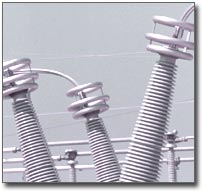
More transmission – again in the Wall Street Journal.
Hard to tell which of the alphabet soups this article is about, and I’d say both, it’s about the Joint Coordinated System Plan and the Upper Midwest Transmission Development Initiative — UMDTI! But we know it’s all one and the same.
The article doesn’t really specifically name either “group” and it leaves us wondering just who or what is behind it. This is a good thing — yes, it really is as amorphous as it sounds! What disturbs me, of course, is the “It’s for wind,” because we know better!
New Grid for Renewable Energy Could Be Costly
FEBRUARY 9, 2009
By REBECCA SMITH
A substantial increase in the amount of electricity produced from renewable energy would require building a transmission system that would carry a price tag of up to $100 billion, according to a new study.
The new system would be needed because the existing eastern grid couldn’t handle the volume of power coming from the wind-producing states. In addition, the new grid would need to be able to handle the fluctuating nature of wind power, which can surge at some moments and drop sharply at others.
There is strong political and public support for increasing production of renewable energy, and Congress is considering enacting a nationwide standard that would require utilities to garner more of their power from renewable sources. However, there is only an emerging understanding of how new standards would affect the country’s existing electricity infrastructure.
The study, sponsored by some of the nation’s biggest grid-running organizations east of the Rockies, is the most comprehensive attempt by the industry to figure out what kind of infrastructure upgrades would be needed if the U.S. attempts to sharply increase the amount of power it gets from sources such as wind and solar. In 2007, according to the Energy Information Administration, about 7% of the nation’s electricity came from renewable sources, including less than 1% from wind.
If the U.S. wants to get 20% of its electricity from renewable energy by 2024, the study says, it would be necessary to build a new electricity circulatory system, including 15,000 circuit miles of extremely high voltage lines. The system, which would be laid alongside the existing electric grid infrastructure, would start in the Great Plains and Midwest — where the bulk of the nation’s wind resources are located — and terminate in big cities along the East Coast.
The transmission system would cost up to $100 billion. Building the wind turbines needed to generate the desired amount of power would cost about $720 billion, the study estimates — making the total investment about equal to the size of the current stimulus bill. The money would be spent over a 15-year period, and would be financed primarily by utilities and investors.
The purpose of the study was “to make clear that if you need large sums of energy that’s not carbon-based, these are the kinds of numbers involved” to achieve it, said Clair Moeller, head of transmission planning for the Midwest Independent System Operator.
The report was prepared by organizations responsible for electric-system reliability in roughly half the states, including the Midwest Independent System Operator, SERC Reliability Region, PJM Interconnection LLC, the Southwest Power Pool, the Mid-Continent Area Power Pool and the Tennessee Valley Authority.
The projected cost of the system is only one hurdle. Getting the high-voltage power lines build across the country would require the assent of local authorities and landowners, and might require federal intervention. “For that 15,000 miles of lines, I promise about 15,000 lawsuits,” said Mr. Moeller.
The report is generating controversy because there is no guarantee that expensive power lines, if built, would be used primarily to move renewable energy. They could just as easily carry energy from coal-fired power plants in the Midwest or Great Plains.
New York and New England grid operators provided information for the report but say there might be ways to build resources in their regions more economically than hauling power from the Great Plains. “This study doesn’t look enough at alternatives to huge transmission additions,” said Stephen Whitley, chief executive of the New York Independent System Operator.
Utilities are proposing to build some new transmission lines already, but nothing on the scale of what the report says would be needed.
At least the WSJ noticed the NYISO and ISO-NE’s objections — here it is again, it’s one of those letters I just can’t get enough of:
Feb 4 2009 NYISO & ISO-NE Letter to JCSP
The UMDTI is insidious, a cheerleading effort to push transmission through. The way the thing is structured, is, as I said in my comments at the February 11, 2009, meeting, is ABSOLUTELY ASS-BACKWARDS. It’s market driven backwards engineering a transmission solution to support nonexistent need.
Upper Midwest Transmission Development Initiative – HOME PAGE
UMTDI Stakeholder Letter 10-28-08
Stakeholder Responses – LINK – look who the stakeholders are – DUH!
Wind on the Wires Comments … sigh…
UMDTI Stakeholder Letter 12-31-08 (Ed Garvey – MISO)
Dec 30 Draft – Cost Allocation Work Group (Marya White – Commerce)
December 30 Draft – Transmission Planning Work Group (Randy Pilo – PSC-WI)
Wind on the Wires cites many studies:
MISO’s Regional Generation Outlet Study (RGOS)
Transmission planning initiatives by” CapX 2020, ATC, Mid-American and others”
Minnesota RES transmission study
MISO’s MTEP-08 and MTEP-09
Joint Coordinated System Planning Stuey
Eastern Wind Integration Transmission Study
None of these studies are linked — and they’re not on the UMTDI site — let’s see how long it takes to find them.
CapX 2020 – they’re HERE
See also the Certificate of Need Appendix A
ATC 10 Year Plan (2008)
MISO’s MTEP 08
Now for the more difficult ones… one moment please…

Leave a Reply